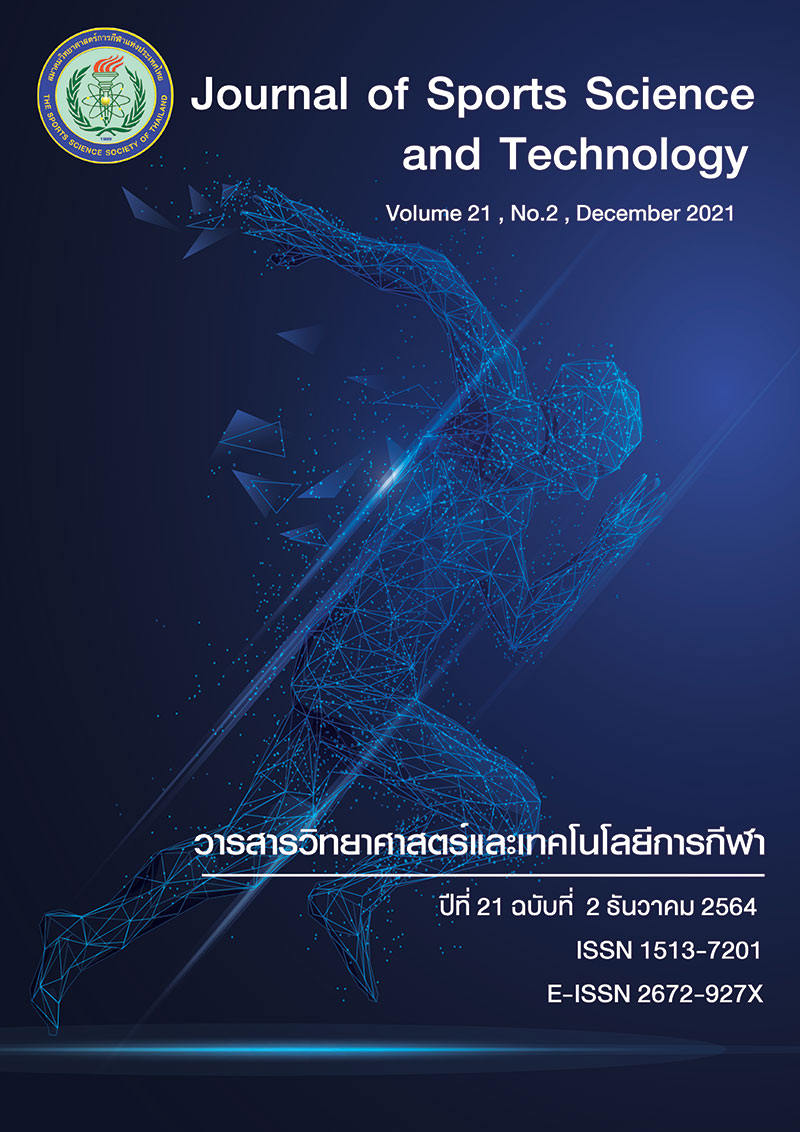ACUTE EFFECTS OF ELASTIC AND RIGID TAPING AT THE ANKLE ON AGILITY AND SELF–CONFIDENCE OF FUTSAL PLAYERS
DOI:
https://doi.org/10.14456/jsst.2021.12Keywords:
Elastic Taping, Rigid Taping, Self–Confidence, Agility, Futsal PlayersAbstract
Futsal is a sport requiring speed and ongoing movement, possibly resulting in ankle pain or injuries. For this reason, futsal players rely on taping to alleviate and prevent injuries prior to competition, affecting their agility and self-confidence. The objective of this research was to investigate and compare acute effects of elastic and rigid taping on at the ankle that on agility and self-confidence of futsal players. This study used cross-over design. The sample of 24 male futsal players in Thailand National Sports University team, Sukhothai Campus with an average age of 19.25±1.51 years used three types of taping, namely: elastic-taping, rigid-taping, and non-taping. Taping duration distance was 72 hours for individual type of taping. Agility was assessed with the FAF's Slalom test and self-confidence was assessed with the CSAI–2R. Results were analyzed and data were compared with One-way repeated measures ANOVA. The results revealed that there were no statistically significant differences between elastic-taping and non-taping group in agility at the 0.05 level. The elastic taping group and the non-taping group had better agility than the rigid taping group with a statistical significance level of 0.05. In addition, the elastic-taping group and rigid taping group had a high level of self-confidence with a statistically significant indifference at the 0.05 level. The non-taping group had a moderate level of self-confidence. The elastic-taping group and rigid group had higher self-confidence than non-taping group with a statistical significance level of 0.05. Therefore, the findings could be concluded that elastic taping at the ankle had higher effects on agility than rigid taping. Elastic and rigid taping at ankle could enhance self-confidence of players than non-taping case.
(Journal of Sports Science and Technology 2021; 21 (2):74-85)
(Received: 18 February 2021 , Revised: 8 July 2021, Accepted: 9 July 2021)
Keywords: Elastic Taping/ Rigid Taping/ Self–Confidence/ Agility/ Futsal Players
*Corresponding Author: Nonthalee SANTINIYOM
Faculty of Sports and Health Science,
Thailand National Sports University Sukhothai Campus, Sukhothai, THAILAND 64000
Email: i.nonthalee@gmail.com
References
2. Worasuman S, Pholcheewin Ch, Lertwimonrat P, Pramolban J,Khunnan P, Keawnamkang P, et al. Futsal referee guide. Bangkok: Department of physical education; 2012.
3. Chankrung A. A study on self-confidence and techniques using by coaches to develop confidence of gymnastic players in the 39th national games. JMSS 2555;8(3):61-74.
4. Riaza LM, Gonzalez HH, Lopez-Alcorocho JM, Garcia PG, Fernandez-Jaen TF. Epidemiology of injuries in the Spanish national futsal male team: a five-season retrospective study. BMJ Open Sport Exerc Med 2017;2:e000180. doi:10.1136/bmjsem-2016-000180.
5. Angoorani H, Haratian Z, Mazaherinezhad A, Younespour Sh. Injuries in Iran futsal national teams: a comparative study of incidence and characteristics. Asian J Sports Med 2014; 5(3);e23070. doi:10.5812/asjsm.23070.
6. Eren U. Investigation of sport injury patterns in female futsal players. Int J Sci Cul Sport 2016; 4(4):474-488.
7. Kemler E, Van de Port I, Schmikli S, Huisstede B, Hoes A, Backx F. Effects of soft bracing or taping on lateral ankle sprain: a non-randomised controlled trial evaluating recurrence rate and residual symptoms at one year. J Foot Ankle Res 2015; 8(13). Doi: 10.1186/s13047-015-0069-6.
8. Bandyopadhyay A, Mahapatra D. Taping in sports: a brief update. J Hum Sport Exerc 2012;7(2):544-552.
9. Bicici S, Karatas N, Baltaci G. Effect of athletic taping and Kinesiotaping® on measurements of functional performance in basketball players with chronic inversion ankle sprains. Int J Sports Phys Ther 2012;4(2):154-166.
10. Constantinou M, Brown M. Sports taping affects perception of performance but does not affect actual jump height and athletic agility performance. J Sci Med Sport 2014; doi: 10.1016/j.jsams.2014.11.343.
11. Leuangrattanachareon N, Papangkornkij N, Panngamta J.Sanga-roon N. Sports injury prevention. Bangkok: Sport science bureau, Department of physical education; 2013.
12. Mohamed MA, Radwan NL, Azab AShR. Effect of kinesio-taping on ankle joint stability. Int J Med Res Health Sci 2016;5(5):51-58.
13. Balsom. Evaluation of physiological performance. Handbook of Sports Medicine and Science Football (Soccer). London: Blackwell Scientific; 1994.
14. Prachakul W. Effect of self-talk skills training on self-confidence. [thesis]. Nakhon Nayok: Srinakharinwirot university; 2004.
15. Singchoo S, Makaje N, Reungthai R. The acute effects warm up with post activation potentiation technique: acute effects on muscle power, speed and agility. J Sports Sci Technol 2015; 15(2):111-122.
16. Khuentong B. Effects of kinesio taping on ankle joint flexibility and jumping ability. [thesis]. Nakhon Nayok: Srinakharinwirot university; 2013.
17. Jaysrichai T. Clinical KT Taping in musculoskeletal condition; December 2015; Faculty of physical therapy, Mahidol university. Nakhon Pathom; 2558.
18. Wang Y, Gu Y, Chen J, Luo W, He W, Han Z, et al. Kinesio taping is superior to other taping methods in ankle functional performance improvement: a systematic review and meta – analysis. Clin Rehabil 2018; 32:1472–1481.
19. Huang ChY, Hsieh TsHs, Lu SzCh, Su FCh. Effect of the kinesio tape to muscle activity and vertical jump performance in healthy inactive people. Biomed Eng Online 2011;10(1):70.
20. Briem K, Eythörsdöttir H, Magnúsdóttir RG, Pálmarsson R, Rúnarsdöttir T, Sveinsson T. Effects of kinesio tape compare with nonelastic sports tape and the untapped ankle during a sudden inversion perturbation in male athletes. J Orthop Sports Phys Ther 2011; 41(5):328-335.
21. Simon J, Donahue M. Effect of ankle taping or bracing on creating an increased sense of confidence, stability, and reassurance when performing a dynamic balance task. J Sport Rehabil 2017; 22(3):229-233.
22. Sawkins K, Refshauge K, Kilbreath S, Raymond J. The placebo effect of ankle taping in ankle instability. Med Sci Sports Exerc 2007; 39(5):781–787.
23. Delahunt E, McGrath A, Doran N, Coughlan G. Effect of taping on actual and perceived dynamic postural stability in persons with chronic ankle instability. Arch Phys Med Rehabil 2010; 91(9):1383–1389.
24. Heatley ML. A strapping culture: The psychological benefits of taping and bracing in sport and exercise [Master's Thesis]. Queensland, School of Psychology: The University of Queensland; 2014.






